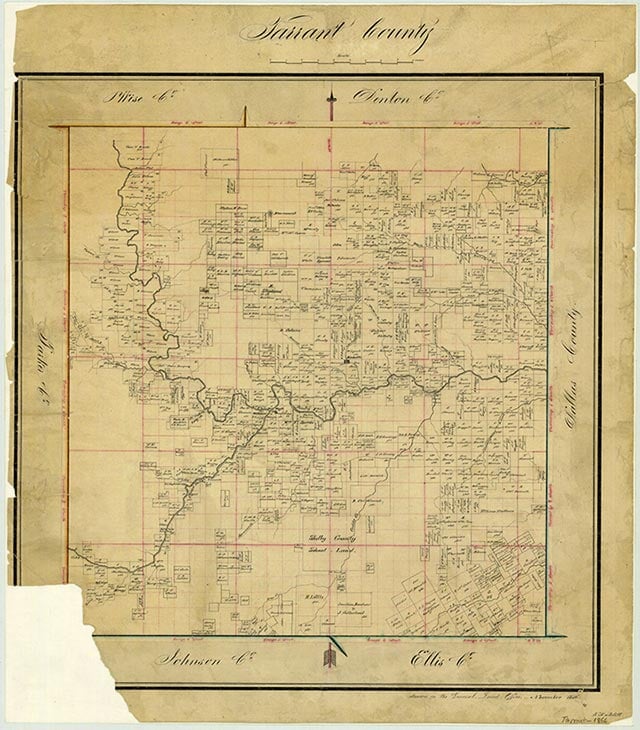Hurst

Hurst, just to the north of Fort Worth, is on State Highways 121 and 10, north of the West Fork of the Trinity River in the northeastern quadrant of Tarrant County. By the middle or late 1840s farmers were beginning to settle within what are now the confines of Hurst. Isaac Parker's log cabin, purchased in 1853, lay just outside what is now the southwestern corner of Hurst, and the Parker family cemetery is now within the city limits. Important among the settlers who moved there after the Civil War were Tennessee families, especially that of William L. Hurst, and Indiana families, including those of Daniel Arwine and Jeff Souder. The Indiana clans established a church and school at the site in the late 1870s and thereafter the community always supported at least one church and one school. The Arwine farming and ranching community grew slowly until the Rock Island line was built through in 1903. William Hurst donated land in exchange for the establishment of a depot named for him. The Rock Island at first labeled the site Hurst, but there was already a Hurst in Coryell County that had a post office. So the budding Tarrant County community was soon named Ormel; it had a post office from 1904 to 1909. The community was renamed Hurst in 1909. The depot and its stationmasters and telegraphers operated for some thirty years. Yet there were probably no more than twenty people in downtown Hurst between 1910 and 1920, and the area's agricultural products-cotton, grain, and cattle-were not enough to make the train stop regularly. Sand and gravel excavations began south of Hurst in the Trinity riverbottoms early in the 1900s; larger round-the-clock operations began in the 1920s. Illegal whiskey was brewed along the wooded river too, selling for about $10 a gallon during prohibition, 1919–1933. After 1903 there was at least one general store in the community, and during the 1930s and 1940s a handful of grocery stores, filling stations, and cafes opened. The Work Projects Administration erected a brick school in 1940, and the population of Hurst numbered perhaps 100. By the 1940s Hurst was becoming a bedroom community for Fort Worth. Its post office was revived in 1949.
Old State Highway 183 (now State Highway 10) was paved with concrete in 1950, and in 1951 Bell Aircraft (Helicopter) announced it would build a plant in Hurst. To prevent Fort Worth from annexing it and to help secure a water supply, Hurst in 1951 voted, 36 to 24, to incorporate. A shopping center and apartments were being built before that year was out. A chamber of commerce organized at Hurst in 1952 and merged with the Euless chamber in 1955; the Bedford chamber joined in 1969. The Hurst and Euless school districts merged in 1955, joined by Bedford in 1958. It was estimated in 1958 that of the 8,500 people living in Hurst, 50 percent worked in Dallas and 40 percent in Fort Worth. Blocked from growing to the south by Fort Worth, Hurst from 1956 to 1958 overzealously pursued annexations in other directions; this triggered intercity tensions and defensive reactions by other "mid-cities" communities. The northeast campus of Tarrant County Junior College (now Tarrant County College) opened in Hurst in 1968, prompting more growth and jobs. During the height of the Vietnam War, the Bell Helicopter workforce topped 11,000, many of them building Hueys. Hurst, Euless, and Bedford formed a hospital district in 1969. By 1970 the population of Hurst was more than 27,200. The North East Mall arrived in 1972, doubling retail sales in Hurst in a month, and in the early 1990s it remained the largest mall in Tarrant County. The construction of the Dallas-Fort Worth International Airport and its January 1974 opening further stimulated the local economy, but in the 1970s the town had almost reached the limits of possible expansion, and its population growth inevitably slowed. Many of the newcomers were professionals and members of the Republican party, which changed the character of the community. The population of Hurst reached 31,400 in 1980, 33,600 in 1990, and 36,273 in 2000. In 2020 the population was estimated to be about 40,000.
George N. Green | © TSHA

Adapted from the official Handbook of Texas, a state encyclopedia developed by Texas State Historical Association (TSHA). It is an authoritative source of trusted historical records.

- ✅ Adoption Status:
- This place is available for adoption! Available for adoption!
- Adopted by:
- Your name goes here
- Dedication Message:
- Your message goes here
Belongs to
Hurst is part of or belongs to the following places:
Currently Exists
Yes
Place type
Hurst is classified as a Town
Associated Names
- [1]
- (Arwine)
- (Ormel)
Location
Latitude: 32.83524790Longitude: -97.18077000
Has Post Office
Yes
Is Incorporated
Yes
Population Count, 2021 View more »
40,055
